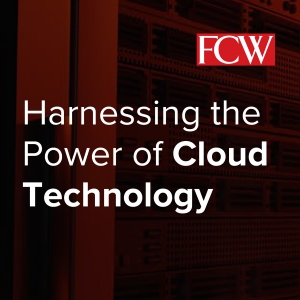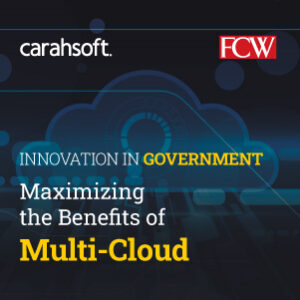During the pandemic, government employees shifted to remote work, and the demand for digital services skyrocketed. To meet those needs, agencies turned to the cloud. The experience gave them a taste of how essential the technology is to modernization efforts. In a recent survey of FCW readers, 87% of respondents agreed with the statement that cloud technology is a foundation for modernization at their agencies. The shift to cloud-based systems often requires a corresponding shift in budgets, employee skill sets and IT management techniques. When asked what steps would enable broader use of cloud technology at their agencies, 79% of FCW respondents said revamping their approach to managing a mix of on-premises and cloud-based systems. One solution is hybrid environments, which blend in-house legacy systems with cloud services, while multi-cloud environments are spread across many cloud platforms and providers. Hybrid environments will likely be the reality for most agencies. In a recent NASCIO survey, 89% of respondents said hybrid cloud was their ideal cloud state. Learn how your agency can determine an optimal cloud strategy in Carahsoft’s Innovation in Government® report.
Cloud’s Unprecedented Capacity for Innovation
“To make data-driven decisions, an agency needs to be able to access its data without concern for capacity constraints based on recent storage and compute contracts. Public cloud services can offer unprecedented scale and speed, and a cloud provider like Google can help government ingest data, and compute as necessary to answer complex analytics questions in real time. Some of our customers have stored tens of petabytes of data in Google Cloud’s serverless, cost-effective multi-cloud data warehouse, BigQuery. Analysts decide what questions they should ask and BigQuery will determine how much computing is necessary to consume it on demand – all without having to manage or configure the underlying infrastructure and services.”
Read more insights from Google’s Head of Customer Engineering for Federal Civilian Agencies, Andy Murphy.
Why Cloud is the Best Path for Modernization
“Accommodating demands to boost engagement while enabling remote collaboration is a complex challenge. At Microsoft, we think about collaboration as an operating model of people, places and processes, and we’re developing capabilities based on the recognition that each dimension has its own nuances, strengths and weaknesses. For example, when cloud technology is combined with the zero trust-based security approach required by the executive order, it facilitates collaboration among government employees by granting access and participation based on identity, physical location and/or the device they’re using.”
Read more insights from Microsoft Federal’s CTO, Jason Payne.
Maximizing Mission Success with the Cloud
 “Most agencies operate hybrid environments that combine on-premises systems with cloud platforms and services. However, there are challenges associated with that approach. Hybrid environments require the ability to manage a diverse set of technologies, tools and operating models and to integrate workloads, applications and services across clouds and on-premises systems. A hybrid cloud environment also changes the traditional security boundary and introduces new vulnerabilities related to the nature of off-premises managed services and the unique attributes of cloud, which include ephemeral services and API-driven, software-defined everything. Fortunately, advanced cloud-based cybersecurity solutions are helping agencies move to zero trust architectures by shifting security services from primary data centers to edge locations to enable rapid analysis and a stronger security posture.”
“Most agencies operate hybrid environments that combine on-premises systems with cloud platforms and services. However, there are challenges associated with that approach. Hybrid environments require the ability to manage a diverse set of technologies, tools and operating models and to integrate workloads, applications and services across clouds and on-premises systems. A hybrid cloud environment also changes the traditional security boundary and introduces new vulnerabilities related to the nature of off-premises managed services and the unique attributes of cloud, which include ephemeral services and API-driven, software-defined everything. Fortunately, advanced cloud-based cybersecurity solutions are helping agencies move to zero trust architectures by shifting security services from primary data centers to edge locations to enable rapid analysis and a stronger security posture.”
Read more insights from Peraton’s Vice President of Cloud and Application Services, Gary Wang, and Cloud Architect and Expert on Public Cloud Products for the U.S. Public Sector, Bob Ferrari.
How to Build an Open Hybrid Cloud Ecosystem
“When agencies have a strong cloud environment, they can leverage open source solutions to achieve key modernization goals, such as improving digital services and making better use of data. That’s because open source is at the heart of all innovation. For the past 20-plus years, open source has been where leading technologists first experiment with new ideas that often become enterprise products. Companies like Red Hat and cloud providers such as AWS, Microsoft and Google begin new projects by working upstream in the open source community and making broadly shared contributions to the Linux Foundation, the Apache Software Foundation and the Cloud Native Computing Foundation. Red Hat Enterprise Linux, for one, is the world’s leading enterprise Linux platform that is fully built on open source software. The open source community is also contributing to agencies’ ability to comply with the Executive Order on Improving the Nation’s Cybersecurity and the government’s zero trust security initiatives.”
Read more insights from Red Hat’s North America Cloud GTM Lead, Tres Vance.
Robust Databases for Modern App Development
“Cloud computing has the ability to scale on demand to support modern application development and meet user demands quickly in a secure environment. That’s why we created Atlas for Government, an independent environment of our flagship cloud product MongoDB Atlas. Atlas for Government allows federal, state and local governments to build and iterate faster using a modern database-as-a-service platform. Our innovative approach gives agencies the versatility they need to modernize legacy applications and support the unique requirements and missions of the U.S. government — in a fully managed and secure environment.”
Read more insights from MongoDB’s Sales Director, Jennifer Hayes.
Adopting Zero Trust Data Security in the Cloud
“On the National Association of State CIOs’ 2022 list of its members’ top priorities, cybersecurity is in the first slot, followed by citizen experience. Those two go hand in hand. When a school is hacked and its data stolen, that school will likely be forced to close for days. When a department of corrections is hit with a ransomware attack, it will be in lockdown. And when a public health department’s systems are breached, it will be unable to provide vital services. Those are real-world examples of impacts that are happening across the country, and they illustrate why government agencies can’t wait until tomorrow to address these vulnerabilities. CIOs, chief security officers and IT directors at all levels of government know they need to do something today because they are vulnerable every minute until they do. At Rubrik, we focus on simplifying the protection of data in the cloud while keeping the citizen experience up and running.”
Read more insights from Rubrik’s Vice President and Head of State, Local Government and Education, Jared Vichengrad.
Three Key Goals for Modern IT Environments
“To take full advantage of cloud-based technological advances, agencies must address their legacy IT. In fiscal 2022 to date, the federal government has spent roughly $83 billion on IT, as reported on ITDashboard.gov. A third, or roughly $34 billion, has been spent on the operation and maintenance of legacy IT systems. The rising cost of maintaining legacy IT crowds out investments in newer cloud-based systems that can better serve citizens and federal workers. Mission-critical legacy applications, technologies and services also have many other dependencies that make modernization difficult. Those dependencies exist in the source code and runtime platforms, leveraging specific databases and using data in proprietary formats. Additionally, agencies have unique processes to manage these applications or services and specialized employees. Simply ripping and replacing mission-critical legacy systems is not an option, so successfully modernizing legacy IT requires addressing those issues.”
Read more insights from Micro Focus Government Solution’s Public-Sector CTO, Kevin Hansen.
A Proactive, Automated Approach to Security
“First, cloud dramatically reduces the time it takes to go from the conception of an idea to production. There are no data center build-outs, no equipment purchases, no months-long planning cycles. With cloud, new technologies can be tested almost instantly. Second, cloud providers offer a nearly infinite selection of tools and applications that are readily available on demand. Third, it may not be universally true that cloud costs less, but when it’s managed right, it absolutely should cost less than on-premises systems. Although cloud technology presents agencies with a tremendous opportunity, trying to manage the extended enterprise as it expands into and across the cloud will require a proactive approach to monitoring and security.”
Read more insights from Oracle’s Director of Solution Engineering, James Donlon.
Data Protection in Hybrid Cloud Environments
“Colonial Pipeline’s situation is something of an anomaly because one study showed that 96% of companies with a trusted backup and disaster recovery plan were able to survive ransomware attacks. However, only 31% of organizations test their disaster recovery plans, which is crucial to ensure that agencies understand the steps involved and can respond effectively in a crisis. Therefore, agencies should choose data protection solutions that include the ability to conduct automated disaster recovery rehearsals on a regular basis. The key to any disaster recovery solution is automation. Without automation, a timely wide-scale recovery is not achievable. Agencies should also be aware that many commercial solutions were born in the enterprise data center and run on architectures that do not support autonomous solutions that scale up or down based on the client’s demand.”
Read more insights from Veritas’s Director of Sales Engineering for Public Sector, Mike Malaret.
Providing a True Mac Experience in the Cloud
“People enjoy the Mac experience and are using more and more macOS-based tools, but they often don’t have remote access to Mac hardware for their jobs. As agencies continue to provide support for remote workers, they must consider how to provide access to Macs for the employees who rely on them for development, design or general office use. Some IT teams set up a physical Mac in a data center and create a network to attach to it, but creating remote access to a machine that’s far away makes it hard to fix problems when they arise. Instead, MacStadium has developed purpose-built technologies that create cloud-based Mac desktops. Cloud Access delivers high-performance remote desktop experiences from the MacStadium cloud to any device. And this year, we are adding Orka Workspaces, which enables high-performance desktop access to cloud-hosted macOS resources via a browser from any workstation or device. Those scalable, flexible technologies can be pushed out on demand to achieve a true Mac experience.”
Read more insights from MacStadium’s Senior Vice President and CTO, Chris Chapman.
Download the full Innovation in Government® report for more insights from these cloud thought leaders and additional industry research from FCW.

 “Imagine you have a massive cache of digital family photos, and you’re looking for images of your child’s kindergarten graduation. Sure, it’s great having all those photos on the computer, but unless you tagged them in some way, there’s no quick way to find what you need. This dilemma mirrors how valuable information can be so difficult to find when it comes in the form of ‘unstructured data.’ Unstructured data includes images, video, audio and other types of information that cannot be stored in traditional databases or analyzed with traditional data tools. Structured data appears in rows and columns that are clearly labeled, making it easy to sort and analyze. Unfortunately, that’s not the case with unstructured data.”
“Imagine you have a massive cache of digital family photos, and you’re looking for images of your child’s kindergarten graduation. Sure, it’s great having all those photos on the computer, but unless you tagged them in some way, there’s no quick way to find what you need. This dilemma mirrors how valuable information can be so difficult to find when it comes in the form of ‘unstructured data.’ Unstructured data includes images, video, audio and other types of information that cannot be stored in traditional databases or analyzed with traditional data tools. Structured data appears in rows and columns that are clearly labeled, making it easy to sort and analyze. Unfortunately, that’s not the case with unstructured data.” “A multicloud approach can be a double-edged sword, with benefits and risks. When agencies have access to a cloud environment, it’s easy for them to spin up new compute resources or storage solutions. But this flexibility opens up risks in terms of performance and security. Even when an agency is working with public cloud service providers, it’s the agency’s responsibility to make sure its resources are configured properly. Many data leakage incidents in the cloud are the result of a configuration issue. Furthermore, in a multicloud environment, technologies are created independently of one another and won’t always work well together. Agencies must make sure they have the appropriate visibility across multicloud environments and on-premises systems so they can understand and manage all aspects of their IT systems. This includes controlling costs and decommissioning purpose-built cloud resources when they are no longer needed.”
“A multicloud approach can be a double-edged sword, with benefits and risks. When agencies have access to a cloud environment, it’s easy for them to spin up new compute resources or storage solutions. But this flexibility opens up risks in terms of performance and security. Even when an agency is working with public cloud service providers, it’s the agency’s responsibility to make sure its resources are configured properly. Many data leakage incidents in the cloud are the result of a configuration issue. Furthermore, in a multicloud environment, technologies are created independently of one another and won’t always work well together. Agencies must make sure they have the appropriate visibility across multicloud environments and on-premises systems so they can understand and manage all aspects of their IT systems. This includes controlling costs and decommissioning purpose-built cloud resources when they are no longer needed.”